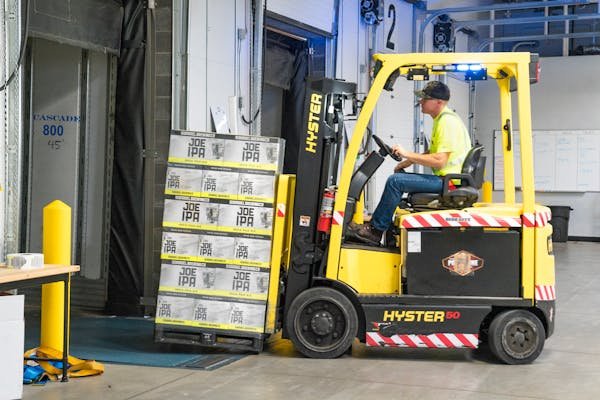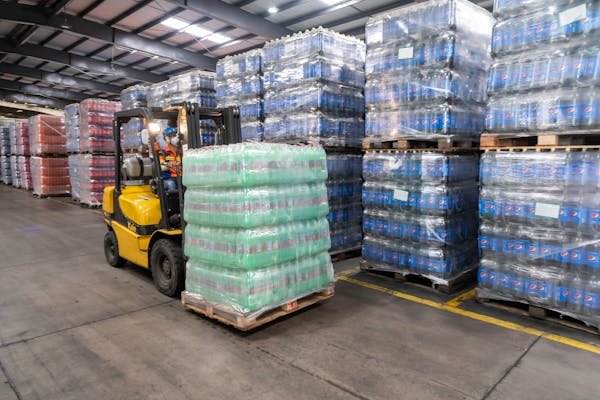Supply chain and logistics are the unsung heroes of modern commerce. From getting food on shelves to making sure your online orders arrive at your door, this industry makes the world go round. But behind the scenes, it’s facing a growing challenge—there simply aren’t enough people to do the work.
1. 73% of supply chain organizations report difficulty in hiring skilled labor
Why it’s happening
Finding skilled talent is now the top hurdle in logistics. More than two-thirds of companies are struggling to hire the people they need. This isn’t just about truck drivers or warehouse staff. It’s also about analysts, planners, procurement experts, and tech-savvy managers.
The demand for skills has changed. With automation, data, and AI making their way into supply chains, workers need to understand software and systems. That shift means traditional hiring methods just aren’t working.
The ripple effect
When skilled roles go unfilled, operations slow down. Inventory piles up in the wrong places. Costs rise. Customer service takes a hit. And your team gets overworked, leading to even more turnover.
If your business is feeling this pain, you’re not alone—but you can’t afford to ignore it.
What you can do
Rethink your job descriptions
Be specific about the skills you truly need. Don’t list every “nice-to-have”—focus on the essentials and be clear about what training you’ll provide.
Partner with training providers
Team up with local colleges, trade schools, or even online platforms to create programs that feed directly into your hiring pipeline.
Look inward
Upskill your current team. It’s often faster and cheaper to train an existing employee than to hire a new one from scratch.
Embrace hybrid skills
Consider hiring talent from other industries who have transferable skills—such as retail or manufacturing veterans who understand fast-paced environments.
2. 57% of logistics companies cite labor shortage as their top operational challenge
A top concern—and growing
More than half of logistics companies now say labor is their #1 problem. That means it’s ahead of fuel costs, ahead of delays, and even ahead of inflation. When you can’t find people to move your product, nothing else matters.
This stat underscores just how central people are to the success of logistics. You can have all the tech in the world, but without boots on the ground, your operation stalls.
What’s behind the shortage
The logistics sector has been expanding rapidly—thanks to e-commerce and global trade. But labor supply hasn’t kept up. COVID-19 pushed many older workers into retirement. Younger workers often see logistics as hard work with limited career growth. And immigration slowdowns have reduced the influx of labor in many regions.
How to tackle this head-on
Improve your employer brand
People want to work for companies that care about them. Make your workplace feel more modern and humane. Highlight your culture, training, and growth opportunities in your job ads.
Streamline your onboarding
Don’t make new hires wait weeks to get started. Cut down paperwork and training time with smart onboarding tools.
Use data to forecast needs
Analyze your seasonal peaks, turnover patterns, and absenteeism. Forecast labor demand so you can plan ahead instead of reacting at the last minute.
Reward problem-solvers
Empower team leads and frontline staff to propose improvements to workflows. Make them part of the solution.
3. The global logistics workforce is aging, with 25% over the age of 55
The silver wave is here
A quarter of logistics workers are now over 55. That means within 5 to 10 years, a big chunk of the workforce could retire. This stat is a wake-up call—it’s not just about today’s labor shortage. It’s about tomorrow’s.
The aging workforce affects all parts of the supply chain. Drivers, forklift operators, supervisors, even dispatchers—many have decades of experience, and their retirement will leave a serious skills gap.
Why this matters now
Older workers carry valuable institutional knowledge. When they leave, they take that experience with them. If companies don’t plan for this, they’ll lose both headcount and know-how.
Worse, the younger generation isn’t rushing to take their place. This generational gap is becoming the next big risk in logistics.
Strategies to bridge the gap
Start succession planning today
Identify who’s likely to retire in the next 3–5 years. Document their workflows. Create mentoring relationships to pass down knowledge.
Offer flexible retirement options
Many older workers are willing to stay on part-time or as consultants. Give them the option to work fewer hours or shift into training roles.
Create intergenerational teams
Pair older and younger workers together. Not only does this build skills, it also improves culture and mutual respect.
Promote the trade
Help change the narrative around logistics jobs. Use social media, community outreach, and partnerships with schools to show that this industry offers real career paths, not just labor gigs.
4. The U.S. trucking industry is short over 80,000 drivers as of 2024
The engine behind America’s economy is missing drivers
The U.S. runs on trucks. Nearly everything you buy—food, electronics, fuel—spends time on a truck. But in 2024, there’s a shortage of more than 80,000 truck drivers, and that number is only expected to grow.
This shortage isn’t a short-term blip. It’s been building for over a decade due to retirements, low entry rates, lifestyle challenges, and regulatory hurdles.
What’s causing this crisis?
First, the average age of a long-haul truck driver is over 47. As older drivers retire, there aren’t enough younger workers replacing them. Second, long-haul driving is a tough lifestyle. Days or even weeks away from home doesn’t appeal to younger generations.
Third, regulatory rules around hours of service and licensing make it harder for new drivers to break in. And finally, the industry has struggled with image—seen as low-tech, isolating, and physically taxing.
What companies can do now
Shorten routes where possible
Redesign logistics to reduce the need for long-haul. Focus on regional or hub-and-spoke models that allow drivers to be home more often.
Invest in driver wellness
Create programs that support mental health, better rest conditions, and safer work environments. Make the role more sustainable for the long haul.
Sponsor CDL training
Help candidates get the training and licenses they need. Offer tuition reimbursement or partnerships with training schools.
Use driver-centric technology
Don’t just install tech to monitor drivers—use it to make their lives easier. Tools like route optimization, rest stop tracking, and automated logs can reduce stress and improve job satisfaction.
5. Warehouse job openings increased by 400% between 2015 and 2023
The demand for warehouse workers has exploded
A 400% jump in warehouse job openings is a staggering number. It reflects how quickly the world has moved toward e-commerce and just-in-time delivery. Companies now need far more people to receive, sort, pick, pack, and ship goods than ever before.
But hiring hasn’t kept up. Facilities are expanding, but people aren’t lining up to work in them.
Why warehouses can’t fill jobs
Warehousing used to be viewed as a steady blue-collar job. But now, high turnover, physically demanding work, and perceived lack of career paths have made it less attractive. Competition from other sectors like manufacturing or construction—often with better pay—also plays a role.
Plus, warehouse locations matter. Many are built on the outskirts of cities where labor is scarce or public transit is limited.
How to make warehouse roles appealing
Modernize the work environment
Good lighting, clean facilities, clear signage, and temperature control go a long way. Make the workplace feel safe and dignified.
Make career growth visible
Map out clear steps for promotions and role changes. Let workers know they can move from picker to supervisor, or from forklift operator to inventory lead.
Offer flexibility
Many workers want predictable hours or flexible shifts. Consider part-time, evening, or weekend roles to attract different types of talent.
Train and certify fast
Have fast-track programs that bring workers up to speed quickly. Use hands-on training, video modules, and peer mentors to reduce onboarding time.
6. 77% of companies report increased labor costs due to talent scarcity
It’s costing more to get and keep workers
When labor is scarce, companies pay more to hire, train, and retain talent. Over three-quarters of firms say labor costs have climbed. And this increase isn’t just about wages—it includes recruitment, overtime, temporary staffing, and retention bonuses.
Labor scarcity is forcing companies to rethink their budget. What used to be a controllable cost has now become a variable that swings unpredictably.
The financial impact is bigger than you think
Rising labor costs can shrink margins fast. In low-margin businesses like fulfillment or transportation, a 10% rise in labor costs might wipe out your profit altogether.
Even if revenue is strong, inefficiencies due to short-staffing—missed deadlines, errors, customer complaints—can increase costs further.
Smart ways to manage labor spend
Benchmark your pay rates
Use local wage data to stay competitive without overpaying. Be strategic—offer more for critical roles and entry points.
Invest in retention before hiring
It’s cheaper to keep a good employee than to replace them. Offer incentives like referral bonuses, recognition programs, and small perks like transportation vouchers or free meals.
Shift from reactive to proactive hiring
Don’t wait for someone to quit. Build a talent pool in advance. Use predictive analytics to see where gaps are coming and start filling them early.
Use automation where it helps—not everywhere
Focus on automating repetitive, dangerous, or high-turnover tasks. But don’t try to replace your entire team overnight—it creates more complexity and risk.
7. Employee turnover in warehousing peaked at 49% annually
Half your team could be gone in a year
Nearly one in two warehouse employees leave their jobs within a year. That’s more than just a staffing issue—it’s a leadership challenge. Turnover at this scale affects morale, quality control, training time, and the bottom line.
Every time someone walks out, your company loses knowledge, productivity, and money. And when turnover is high, it becomes harder to attract new talent—no one wants to join a revolving door.
What’s behind this high churn?
There are a few key reasons. First, warehouse jobs can be physically intense. Repetitive lifting, long hours, and demanding pace can wear people down fast. Second, many workers feel there’s no clear path forward. If you don’t see growth, it’s easy to walk away.
Then there’s scheduling. Rigid hours or unpredictable shifts make it hard for people to balance life and work. Add to that a lack of recognition or basic feedback, and even good workers begin to drift.
How to lower turnover and keep your team engaged
Make the first 90 days count
This is the most critical period. Use structured onboarding, mentorships, and frequent check-ins. Don’t just throw new hires into the workflow—make them feel supported.
Create mini-milestones
Reward progress. Celebrate 30, 60, and 90-day anniversaries. Offer small raises or title changes after proven performance.
Talk to your people
Don’t rely only on surveys. Walk the floor. Ask about what’s working and what’s not. Fix small frustrations—like broken tools, slow systems, or bad lighting—fast.
Promote from within
Highlight success stories of current supervisors who started in entry-level roles. This makes growth feel real and keeps ambition alive.
8. E-commerce growth has caused a 40% increase in demand for warehouse workers
Online shopping changed everything
E-commerce isn’t just a trend. It’s now the default way millions of people shop. And with that shift, companies need more warehouse space, more workers, and faster fulfillment than ever before.
A 40% jump in demand for warehouse labor is massive. But the supply of workers hasn’t grown at the same pace. That’s created fierce competition for talent and made it harder for smaller companies to keep up.
Why e-commerce strains labor capacity
E-commerce requires different workflows than traditional retail. Items need to be picked in small quantities, packed individually, and shipped directly to customers. That means more human involvement, more picking and scanning, and more complexity.
And because customer expectations are sky-high—think 2-day delivery—there’s little room for delays or errors. That raises the pressure on every warehouse worker.
How to adapt to e-commerce’s labor demands
Use zone-based picking
Divide your warehouse into sections and assign workers to one area. This reduces walking time and makes the work more manageable and efficient.
Improve inventory visibility
Use barcodes, real-time dashboards, and basic WMS tools to reduce mistakes. The smoother your inventory flow, the less stress your workers face.
Prepare for peak season early
E-commerce demand spikes during holidays. Start hiring and training temp workers months ahead. Give them a clear path to become permanent if they perform well.
Use micro-fulfillment centers
Consider smaller, localized facilities near cities. They reduce delivery times and require fewer staff than mega-warehouses, making them easier to run.
9. Only 6% of Gen Z consider a career in logistics
A future pipeline problem
This stat is a red flag. If only 6% of Gen Z sees logistics as a career path, the industry is heading for a severe talent drought in the coming years. Gen Z is the future workforce—but right now, supply chain isn’t even on their radar.
That’s a branding issue. Young people aren’t avoiding logistics because they know it and dislike it. They’re avoiding it because they don’t understand it.
Why Gen Z isn’t choosing logistics
Gen Z wants purpose-driven work. They value tech, flexibility, creativity, and social impact. Unfortunately, logistics is often seen as rigid, repetitive, and old-school. It doesn’t help that most school career counselors rarely mention supply chain roles.
Also, many logistics roles are still presented as “back-office” or “entry-level,” with little visibility into how these jobs power global commerce.
How to win over the next generation
Tell better stories
Highlight how logistics supports hospitals, disaster relief, and sustainability. Use videos, social media, and real employee voices to showcase the impact of your work.
Go where Gen Z is
Be active on platforms like TikTok, Instagram, and YouTube. Share behind-the-scenes content that shows how cool, fast, and high-tech your operations really are.
Offer internships and early exposure
Partner with high schools, trade schools, and colleges to create logistics programs, tours, and workshops. Early exposure is key.
Modernize roles
Introduce tech-powered jobs like inventory analytics, robotics maintenance, or logistics coordination with real-time dashboards. Make sure your job titles and descriptions reflect the innovation happening in your workplace.
10. Automation adoption in logistics increased by 30% due to labor constraints
When people are scarce, robots step in
Labor shortages have pushed logistics firms to automate faster than ever. In fact, automation adoption jumped 30% as companies struggled to fill roles. This isn’t about replacing people. It’s about survival. Automation is being used to ease pressure, reduce repetitive tasks, and help teams do more with less.
From conveyor belts and robotic arms to inventory scanners and software bots, automation is reshaping how warehouses and distribution centers run. And it’s becoming essential—not optional.
Why automation is accelerating now
There are a few driving factors. First, the cost of unfilled roles has gone up. When every open job delays shipments, automation suddenly looks cheap. Second, technology is more accessible than ever. What used to require millions in capital now costs much less. Even mid-size companies can adopt automation tools quickly.
And finally, the pandemic highlighted the need for resilience. Automation doesn’t call in sick, take breaks, or leave for a better offer.
How to embrace automation without losing your team
Automate to assist, not replace
Use technology to reduce fatigue, not eliminate jobs. For example, automated picking carts can cut walking distance and make workers more productive without taking away their roles.
Start with low-risk areas
Begin with repetitive or high-error tasks like scanning, label printing, or inventory counts. These changes are easy to implement and show quick results.
Involve your team
Let your employees know automation is there to help them. Ask for their input. They often know exactly where automation would help most.
Upskill alongside automation
As you add machines, train your staff to operate and maintain them. This turns warehouse workers into tech-enabled operators, which adds value for both sides.
11. The average time to hire a warehouse worker is now 42 days
It’s taking too long to fill roles
In a fast-moving industry like logistics, 42 days is a long time to leave a role unfilled. But that’s the average time it now takes to hire a warehouse worker. Every day that role stays open, productivity drops and the load on your team increases.
For an industry built on speed and precision, slow hiring is a dangerous drag.
Why hiring takes so long
There are three key reasons. First, the hiring pool is smaller. Second, the competition is fierce. Third, the process is often outdated—manual steps, delayed interviews, and slow decision-making all contribute to lost time.
On top of that, candidates have more options. If your process takes weeks, they’ll choose an employer who moves faster.
How to speed up your hiring process
Cut unnecessary steps
Review your hiring workflow. Eliminate redundant interviews, slow approvals, or paperwork that can be digitized. Streamlining could shave off days—or even weeks.
Use mobile-first applications
Make it easy to apply from a phone. Gen Z and hourly workers often use their phones for job searches. Long, clunky desktop applications can turn them off instantly.
Set hiring sprints
Dedicate 2–3 days to fast-track interviews and decisions. Bring in all stakeholders, review candidates in real-time, and make offers within 24 hours.
Keep backup candidates warm
If you find two strong applicants but only hire one, keep the second in your system. Build a talent bench so you’re never starting from zero.
12. 65% of firms report overtime as a main tactic to handle labor shortages
The quick fix that comes with a cost
When there aren’t enough hands, companies often turn to one thing—overtime. Nearly two-thirds of logistics firms rely on extended hours to bridge labor gaps. It’s fast, flexible, and cheaper than hiring new staff. But it’s also risky.
Too much overtime leads to burnout, errors, injuries, and—ironically—even more turnover.
Why overtime is the go-to move
Overtime is easy to control. You don’t need to train someone new, run background checks, or post job ads. Just ask your current team to do more. It’s effective in the short term—but the long-term toll can be steep.
Workers start to resent long hours, morale drops, and health issues rise. The quality of work suffers, and your team starts checking out mentally and physically.

Smarter ways to manage overtime
Track it closely
Use dashboards to monitor who’s working how much. Identify patterns of overuse before they become dangerous.
Rotate responsibility
Spread overtime across the team fairly. Don’t rely on the same people every week. Rotation helps prevent fatigue and resentment.
Offer shift flexibility
Instead of forcing 10-hour days, consider adding a second short shift or weekend crew. It spreads the load and makes hours more manageable.
Hire part-time floaters
Create a pool of part-time or seasonal workers who can step in during peak times. It’s cheaper than full-time hiring and avoids constant overtime.
13. Women make up only 22% of the logistics labor force
A huge talent pool left untapped
Only 22% of logistics roles are held by women. That means the industry is operating with one hand tied behind its back. At a time when every pair of skilled hands counts, excluding or overlooking half the population is not just unfair—it’s unsustainable.
This stat reveals a long-standing gap in diversity. And it’s not just about fairness. More inclusive teams are better at problem-solving, decision-making, and adapting to change.
Why women stay away from logistics
Logistics roles—especially in warehousing, transportation, and operations—have often been seen as physically demanding, male-dominated, and rigid. The work environment has historically lacked flexibility, support for caregivers, and visible female leadership.
Many women don’t even see logistics as an option. The sector rarely shows up in recruitment campaigns aimed at women, and even fewer success stories are shared publicly.
How to attract and retain more women in logistics
Change your messaging
Start by showing that logistics is for everyone. Feature women in your recruitment materials, social posts, and career stories. Representation matters.
Offer flexible shifts
Childcare responsibilities often fall on women. Offering predictable schedules, part-time roles, or split shifts can make logistics roles more accessible.
Create safe, inclusive workspaces
Make sure your facilities are well-lit, clean, and welcoming. Address harassment swiftly. Ensure proper restroom access and break areas for everyone.
Build internal support networks
Mentorship programs, women’s leadership circles, or internal resource groups can create a sense of belonging and help develop future leaders.
14. Absenteeism in logistics roles rose 18% post-2020
More workers are missing more days
Since 2020, absenteeism has spiked by 18% across logistics roles. That means more missed shifts, more unplanned gaps, and more scrambling to fill them. This rise isn’t just about sickness. It reflects burnout, mental health challenges, family obligations, and in some cases, disengagement.
When absenteeism climbs, everything slows down. Deliveries miss their windows. Orders pile up. And stress spreads like wildfire across your team.
What’s driving this uptick?
The pandemic fundamentally changed how people view work. Many reassessed their health, their priorities, and their tolerance for high-pressure jobs. If they felt unsafe, unsupported, or underappreciated, they were more likely to call out.
And with thin staffing already in place, even a few absences can break the system.
How to reduce absenteeism without pushing too hard
Start with empathy
People don’t skip work just because. Find out what’s behind the absences—family issues, burnout, fear of illness—and see what support you can offer.
Make schedules predictable
When people know their hours in advance, they can plan their lives better. This reduces no-shows due to last-minute conflicts.
Offer paid sick days
Yes, it’s a cost. But the long-term benefit is better health, more loyalty, and fewer surprise call-outs due to untreated issues.
Recognize good attendance
Instead of punishing absenteeism, reward reliability. Small bonuses, gift cards, or public recognition can go a long way in reinforcing good habits.
15. 69% of logistics employers are increasing wages to attract talent
Money talks—but it’s not the whole story
Nearly 70% of logistics firms are raising wages to lure in workers. That’s a clear sign of just how tight the talent market has become. Better pay definitely helps, especially in a competitive hiring landscape. But it’s not a silver bullet.
Many companies quickly learn that higher wages don’t solve all their labor problems. If the culture, schedule, or growth path is broken, money only masks the issue—it doesn’t fix it.
Why companies are turning to pay raises
When your job listings go ignored and your competitors are offering signing bonuses, it’s hard not to raise the stakes. Higher pay is the simplest, most visible way to get attention.
It’s also a way to boost retention. Employees who feel underpaid are more likely to leave—even if they like the job otherwise.
How to make pay increases part of a bigger strategy
Link pay to clear milestones
Offer structured wage increases tied to tenure, performance, or skills training. This encourages growth and loyalty.
Communicate total compensation
Help employees see the full value of what you offer—not just hourly pay. Include bonuses, benefits, paid time off, and perks in your messaging.
Make raises meaningful
A tiny bump won’t cut it. If you raise wages, do it enough to actually change behavior and perception.
Pair raises with improvements
Fix working conditions, break policies, or shift flexibility alongside pay increases. It signals that you’re investing in people, not just making a PR move.
16. Labor shortages contributed to a 15% increase in last-mile delivery delays
The final mile is getting slower
Last-mile delivery is the most visible part of the supply chain for customers. It’s also the most complex and expensive. And thanks to labor shortages, it’s become even harder to manage. A 15% rise in last-mile delays means more missed delivery windows, frustrated customers, and damage to brand reputation.
Customers don’t care what’s happening behind the scenes—they just want their package. But for logistics teams, finding enough drivers, dispatchers, and route planners has become a daily battle.
Why last-mile is so labor-sensitive
Unlike warehousing or long-haul shipping, last-mile delivery is highly fragmented. It often relies on local drivers, gig workers, and small third-party fleets. When these roles go unfilled or people call out, deliveries get rerouted, delayed, or dropped.
There’s also no room for error. One missed address or a short-staffed day can throw off the entire route. And with expectations for same-day or next-day delivery, there’s no buffer.
How to reduce last-mile delays despite staffing challenges
Use route optimization software
Smart routing tools cut down on time, fuel, and confusion. Fewer wrong turns and wasted miles mean fewer delays—especially helpful when you’re short on drivers.
Cross-train your warehouse staff
In urgent situations, staff trained in both fulfillment and delivery can step in. Having flexible, multi-skilled workers adds resilience.
Offer delivery windows with slack
Rather than promising tight timeframes, give customers realistic delivery windows and live tracking. This reduces pressure on drivers and improves satisfaction.
Work with local delivery partners
Build a network of on-demand couriers or local service providers who can jump in during peak times. These partnerships can fill gaps without long-term hiring.
17. 51% of warehouse workers cite burnout as a reason for quitting
The human cost of running lean
Over half of warehouse workers who leave say they’re burned out. That’s not just fatigue—it’s emotional exhaustion, mental strain, and physical wear-and-tear from jobs that ask too much and give too little back.
This stat is a clear warning. If burnout is driving exits, then solving turnover isn’t just about pay or perks—it’s about how the work feels, every day.
What’s burning people out?
It’s the repetitive tasks. The heat. The noise. The pressure to meet quotas. The missed breaks. The mandatory overtime. It adds up.
Many workers feel like cogs in a machine—unseen, unheard, and replaceable. When management is distant, communication is poor, and recognition is rare, burnout creeps in fast.
How to fight burnout before it’s too late
Redesign the day-to-day experience
Break long shifts with real rest breaks. Rotate tasks so people aren’t stuck doing the same motion for hours. Add music, airflow, or basic comforts to make the space more livable.

Make quotas realistic
Metrics are necessary, but they must be human. Re-evaluate your KPIs to ensure they’re achievable and that quality isn’t being sacrificed for speed.
Train your managers to care
Good frontline leadership makes all the difference. Equip your supervisors to spot burnout signs early and handle complaints with empathy.
Celebrate effort, not just results
Recognize hard work regularly, not just when numbers are met. Sometimes, showing appreciation is more powerful than a bonus.
18. The average cost of a vacant supply chain role is $13,000/month
Every empty seat is a drain
When a supply chain role stays vacant, it costs you. Not just in missed output—but in overtime, delays, rework, and lost opportunities. On average, each unfilled position costs around $13,000 every month.
That’s a painful number, especially if you’re dealing with multiple vacancies. And the longer a role stays open, the more expensive it gets—not just in dollars, but in team morale and service quality.
Why vacancies are so costly
Logistics is a chain. When one link is weak or missing, the whole system slows down. An open forklift driver position means delayed picking. A missing planner means poor inventory allocation. A vacant dispatcher role means routing mistakes.
Teams try to cover the gap, but that means overworking your people, increasing the chance of errors, and stretching your operations thin.
How to reduce vacancy costs fast
Build a standby roster
Have a list of pre-vetted candidates or former employees who can jump in quickly. Treat it like a reserve team.
Use internal mobility
Look inside your company before hiring out. A motivated worker from another department might be ready for a switch—with minimal ramp-up.
Create “plug-and-play” roles
Design certain positions to be easily filled with minimal training. Use SOPs, checklists, and digital tools to onboard quickly and reduce learning curves.
Measure the hidden costs
Track not just the hiring budget, but the real cost of vacant roles—missed shipments, delayed invoices, customer complaints. When leadership sees the numbers, they prioritize hiring faster.
19. Cross-training programs have increased by 37% to manage workforce gaps
Flexibility is the new superpower
As labor shortages stretch teams thin, companies are turning to cross-training. It’s a simple concept: teach employees to do more than one job. And it works. Cross-training program adoption is up 37%, and it’s making a real difference in day-to-day operations.
Instead of scrambling to hire, businesses are unlocking more value from the team they already have.
Why cross-training works
When someone calls out sick or quits unexpectedly, a cross-trained employee can step in. That keeps workflows moving, reduces downtime, and builds a sense of teamwork. It also makes the work more interesting—people aren’t stuck in one repetitive role forever.
Cross-training isn’t just a backup plan. It’s a long-term investment in a more resilient workforce.
How to build an effective cross-training program
Start with critical roles
Identify which positions are most likely to go unfilled or cause disruptions. Train backups for those first. Focus on forklift operation, order picking, and dispatch coordination.
Use a buddy system
Pair experienced workers with trainees during slower hours or quieter days. Learning by doing beats formal training every time.
Make it part of onboarding
Don’t wait until someone’s been around for years. Introduce the idea of flexibility from day one. Make cross-training part of the culture.
Track skills in a shared matrix
Use a simple spreadsheet or tool that shows who’s trained in what. That way, when someone’s out, you know exactly who can cover.
20. 46% of logistics firms are investing in upskilling to retain employees
People stay when they grow
Nearly half of logistics companies are now putting money into upskilling—teaching their workers new abilities. And it’s not just because it makes workers more useful. It’s because it makes them more likely to stay.
When employees feel like they’re learning, advancing, and building a career—not just clocking in and out—they stick around. Upskilling turns jobs into careers.
What upskilling really means
Upskilling isn’t just training someone to use a scanner or operate a lift. It can include teaching leadership skills, data entry, software tools, safety compliance, or process improvement.
It’s about helping workers move up, not just do more of the same.
How to create an upskilling plan that pays off
Start with employee goals
Ask your team what they want to learn. Some may want to move into planning, others into tech or safety. Align their ambitions with your needs.
Offer bite-sized learning
You don’t need a full course catalog. Offer short, focused sessions—30-minute modules or weekly skills labs. Make it easy to learn without slowing down work.
Tie it to promotions
Make upskilling part of the path to higher pay or leadership roles. When learning equals advancement, people take it seriously.
Celebrate learning openly
Give shoutouts, certificates, or digital badges when someone finishes a course. Recognition fuels momentum.
21. Urban warehouse labor availability is down 21% in major U.S. cities
The city isn’t what it used to be
Urban warehouses were once prized for their proximity to customers. But today, they face a major challenge: there just aren’t enough workers. Labor availability has dropped by 21% in key U.S. cities. That’s slowing down fulfillment and pushing companies to rethink where and how they operate.
This isn’t about a lack of people—it’s about a mismatch between jobs and local workforce needs.
Why cities are struggling
Urban areas are expensive. Workers face high living costs, long commutes, and limited transit options to reach industrial zones. Younger residents may also prefer office-based or tech-forward roles.

At the same time, zoning laws and real estate costs make expanding or modernizing city warehouses difficult. So companies are stuck with older facilities that don’t appeal to today’s labor market.
What to do when urban labor runs dry
Rebalance your network
If your city location can’t support full capacity, consider shifting some volume to suburban or rural fulfillment centers. Use the city site as a spoke, not the hub.
Offer transit stipends
Help workers afford the commute. Offer shuttle services, public transit cards, or mileage reimbursements to make the job accessible.
Use satellite staffing
Partner with staffing agencies or gig platforms that specialize in short-term, on-call urban labor. It’s flexible and helps smooth demand spikes.
Rethink the workplace
Make city warehouses more attractive. Better lighting, air circulation, locker rooms, food access—these small upgrades go a long way in attracting and retaining workers.
22. 74% of logistics CEOs are re-evaluating location strategy due to labor access
Labor is reshaping the supply chain map
Traditionally, companies picked warehouse and distribution center locations based on proximity to ports, highways, or big markets. But today, a new factor is dominating those decisions—access to labor. A full 74% of logistics CEOs are now reconsidering location strategies specifically because they can’t find enough workers where they are.
This is a major shift. It means labor is no longer just an HR issue—it’s a top strategic priority.
Why location strategy is evolving
If you build in an area with low labor availability, everything becomes harder. You face constant vacancies, rising wages, poor morale, and unreliable service. Even the best facility layout or tech investment won’t make up for an empty warehouse.
The new approach? Choose locations where people want to work, not just where goods want to go.
How to make smarter location decisions
Use labor market data early
Before signing a lease or breaking ground, research local unemployment rates, wage trends, and competition. Look beyond total population—focus on skill availability and commute patterns.
Balance cost with labor supply
A cheaper location might seem like a win, but if you can’t hire, those savings evaporate fast. Don’t optimize for rent if it kills productivity.
Test with micro-fulfillment centers
Instead of betting big, try small. Launch a temporary or mobile site to test labor access and delivery performance before scaling up.
Think about quality of life
Workers value areas with affordable housing, short commutes, and access to services. Pick locations where people can build their lives—not just clock in.
23. Over 30% of drivers leave the profession within the first 6 months
The turnover trap starts early
It’s a tough pill to swallow—almost one-third of new drivers quit before their first six months are up. This early turnover costs the trucking industry millions and leaves logistics operations constantly scrambling to fill gaps.
The most painful part? Many of these hires had potential. They simply weren’t prepared for the job’s realities, or they didn’t feel supported during the transition.
Why new drivers walk away so fast
Driving is a demanding lifestyle. Long hours. Isolation. Stressful schedules. And many new drivers are surprised by the pressure—especially if they’re fresh out of training.
Onboarding is often weak. New drivers may feel lost, alone, or even unsafe. If no one checks in regularly, they silently disengage before quietly quitting.
How to reduce first-year driver turnover
Create a 90-day retention plan
Set up a structured check-in process for the first three months. Regular phone calls, on-the-road mentors, and quick feedback loops can keep new drivers engaged.
Pair rookies with veteran mentors
A buddy system works wonders. Experienced drivers can help troubleshoot real-world issues that no classroom ever covers.

Set realistic expectations upfront
Don’t oversell the role. Be honest about the lifestyle, the pay ramp-up, and the day-to-day challenges. Let people opt out early if it’s not a fit.
Celebrate early wins
Recognize milestones—first solo trip, 30-day mark, first customer kudos. Small celebrations help new drivers feel seen and valued.
24. 80% of 3PLs report challenges finding qualified forklift operators
Skilled hands are hard to find
Forklift operators are essential to moving goods inside warehouses. But for third-party logistics providers (3PLs), finding qualified operators has become a major bottleneck. A staggering 80% of 3PLs report difficulty filling these roles.
It’s a specific, technical job—and one with real safety implications. That means you can’t just hire anyone off the street. Certification, experience, and attention to detail all matter.
Why forklift roles are so hard to fill
First, not everyone has a forklift license. Training and certification take time and money, and many job seekers skip over roles that require them. Second, good operators are often poached quickly by larger employers or companies offering signing bonuses.
Plus, younger workers may not see forklift driving as a stepping stone to growth—and if there’s no clear career path, they’re not likely to stick around.
How to secure and keep top forklift talent
Pay for training and certification
Remove the barrier to entry by covering the cost of certification for new hires. Make it part of onboarding.
Offer clear safety incentives
Create bonus systems tied to accident-free streaks or efficiency benchmarks. Skilled operators care about safety—reward that focus.
Rotate responsibilities
Forklift driving can get repetitive. Let operators take on related tasks like inventory audits, team training, or safety walkthroughs. It keeps them engaged and helps them grow.
Host skill-building events
Hold forklift rodeos, challenges, or workshops that reinforce pride in the role. When people feel respected and empowered, they’re more likely to stay.
25. 54% of companies are using temp staffing to meet peak season demands
Short-term help for long-term pressure
More than half of logistics companies now rely on temporary staffing to handle peak periods. Whether it’s the holiday rush, end-of-quarter spikes, or back-to-school surges, temp workers are filling the gaps when full-time staff just isn’t enough.
Temporary staffing is a pressure valve. It keeps things moving without long-term commitments—but it also comes with its own set of risks and tradeoffs.
Why temp labor is a go-to solution
It’s fast, flexible, and often less costly than full-time hiring—at least in the short term. Temp workers can step in for specific shifts, help scale up operations quickly, and give managers breathing room.
But relying too heavily on temps can lead to inconsistent work quality, higher training needs, and reduced team cohesion.
How to get the most out of your temporary workforce
Create a temp onboarding kit
Give every temp worker a quick, clear orientation—site layout, safety rules, daily workflows. A 30-minute investment saves hours of mistakes.
Use temp-to-perm as a filter
View temp staffing as a tryout program. If someone performs well, offer them a permanent spot. You’ll already know they fit the culture.
Mix temps into stable teams
Don’t isolate temp workers. Pair them with experienced full-timers who can answer questions and guide them through the day.
Plan early with staffing partners
Start recruiting temp workers months in advance. Good agencies get booked quickly. Build a relationship with one or two partners you trust to deliver consistent talent.
26. Labor costs now account for up to 70% of total warehouse operating expenses
People are your biggest investment
Labor isn’t just a cost—it’s the biggest one. In some warehouses, it makes up 70% of all operating expenses. That includes wages, benefits, overtime, training, and temporary staffing. When labor isn’t optimized, profits suffer.
But this stat also points to an opportunity. If you can improve how labor is managed—even a little—you unlock serious savings and performance gains.
Why labor dominates the cost structure
Unlike buildings or forklifts, people need to be paid every week. And because logistics is still largely hands-on, there’s no way around it. Even with automation, someone needs to load trucks, scan items, plan inventory, and manage operations.
High turnover, absenteeism, and inefficient processes only make labor costs spike higher.
How to bring down labor costs without cutting corners
Improve process efficiency
Small changes to layout, workflow, or software can reduce time spent per task. Time saved is money saved.
Track true productivity
Don’t just count hours worked. Measure output per hour, per team, per shift. Use this to reward top performers and coach others.
Use performance-based pay wisely
For roles with clear metrics (like picking or packing), offer bonuses for efficiency and accuracy. It motivates and helps justify labor spend.
Bundle benefits smartly
Rather than increasing base pay constantly, offer health perks, scheduling flexibility, or educational support. It often costs less and has greater retention impact.
27. The average hourly wage for warehouse workers increased 19% since 2021
Pay is rising—and it’s not slowing down
Wages for warehouse workers have jumped nearly 20% since 2021. This sharp rise reflects the ongoing competition for talent. In a world where jobs are plentiful and loyalty is low, higher pay is one of the few levers employers can quickly pull.
But this trend also creates budget pressure and forces companies to think differently about compensation and value creation.
What’s driving the wage increases?
Simple supply and demand. There are more open roles than there are people to fill them. That’s pushed companies to offer higher wages, signing bonuses, and retention incentives. Inflation has added to the pressure—workers expect more just to keep up with the cost of living.
And when one major player in a region boosts wages, others have to follow to stay competitive.
How to manage rising wages wisely
Get ahead of the curve
Don’t wait until people leave. Review market wages regularly and adjust proactively. Being a “top-tier” employer is cheaper than constantly rehiring.
Offer value beyond pay
When you can’t outpay the competition, offer other things: better hours, safer environments, clear advancement, or unique benefits like transportation stipends.

Build a culture of respect
Many workers will stay for $1 less per hour if they feel appreciated and secure. Don’t underestimate the power of daily recognition, good management, and psychological safety.
Use tiered wage structures
Reward loyalty with predictable raises at 3, 6, and 12 months. It encourages retention and makes budgeting easier.
28. 62% of logistics firms report scheduling difficulties due to understaffing
Juggling the schedule has become a daily battle
Over 60% of logistics companies say they’re struggling to create and maintain reliable schedules. And the root cause? Not enough people on the roster. Understaffing doesn’t just affect output—it affects when and how that output can happen.
Schedules become unstable. Shifts go unfilled. Overtime creeps in. And managers spend more time moving pieces around than focusing on performance or strategy.
Why scheduling is so hard right now
With high turnover, absenteeism, and worker shortages, there’s just not enough predictability. Even when you post a schedule, callouts or no-shows can unravel it in minutes. On top of that, younger workers want flexibility—fixed shifts are no longer the norm.
The result is constant tension between labor availability and operational needs.
How to create stronger, smarter schedules
Use scheduling software—not spreadsheets
Automated scheduling tools can track availability, preferences, and compliance rules. They also update in real-time, reducing manual work and miscommunication.
Allow self-scheduling where possible
Let employees pick or trade shifts within certain guardrails. This gives them more control and reduces resentment.
Keep a standby pool
Have a list of part-time or flex workers ready to jump in on short notice. Offering incentives for on-call availability can make this more sustainable.
Build buffers into the schedule
If you need 10 people to run a shift, schedule 11. That buffer absorbs last-minute gaps without burning out your core team.
29. Driver detention times increased by 21% due to staff shortages at docks
When the loading dock slows, everything backs up
A 21% rise in driver detention time is more than just a delay—it’s a cost multiplier. Drivers get stuck waiting to be loaded or unloaded because there aren’t enough dock workers, gate clerks, or warehouse personnel available.
And when drivers wait, they’re not delivering. That delays freight, reduces daily miles, and pushes up rates. It also contributes to driver dissatisfaction and turnover.
What’s causing longer detention times?
Short-staffed docks are the biggest culprit. When teams are stretched thin, it takes longer to assign a dock, prepare loads, and complete paperwork. Scheduling mismatches and poor communication between dispatch and facility teams make it worse.
Even experienced teams struggle when support roles—like yard spotters or clerks—go unfilled.
How to cut detention time even with a lean crew
Improve appointment accuracy
Make sure loads are actually ready when drivers arrive. Sync dispatch systems with warehouse prep workflows to avoid early arrivals or false starts.
Use mobile check-in/check-out systems
Automated gate entry, mobile apps, or digital dock assignments can save 15–30 minutes per load. It reduces face-to-face delays and frees up staff.
Assign a detention watchdog
Designate one person to monitor loading/unloading flow and resolve slowdowns. Often, a small issue left unattended becomes a major block.
Reward speed and communication
Incentivize dock teams for meeting loading time targets. Recognize departments that improve turnaround consistency.
30. The global logistics sector needs to add 2.1 million workers by 2030 to meet demand
The future workforce gap is massive
The final stat is also the most forward-looking—and the most urgent. To keep up with global logistics demand, the industry will need to add over 2.1 million workers by the end of the decade. That includes drivers, warehouse workers, tech specialists, planners, and more.
If the gap isn’t closed, the consequences will cascade: slower trade, higher prices, failed deliveries, and stalled growth.
Why demand keeps rising
E-commerce is still growing. Consumer expectations are climbing. Supply chains are getting more complex. Sustainability initiatives, reshoring, and geopolitical shifts are creating more nodes, more lanes, and more variables to manage.
But talent pipelines haven’t expanded at the same rate. Vocational training is lagging. Younger generations aren’t being recruited aggressively. And industry perception hasn’t caught up with its reality.
How to start preparing now for 2030
Partner with education providers
Work with trade schools, colleges, and even high schools to introduce logistics career paths early. Sponsor programs that teach real-world supply chain skills.
Build from within
Develop junior staff into future leaders. Offer clear training ladders, management tracks, and cross-functional experiences.

Invest in employer branding
Change the way people think about logistics. Highlight purpose, technology, career growth, and innovation. Show that this isn’t just about moving boxes—it’s about moving the world.
Think global, act local
Labor shortages aren’t equal everywhere. Consider international recruitment, but also build local loyalty by supporting communities, offering real wages, and treating people like the long-term assets they are.
Conclusion
Labor shortages in supply chain and logistics are not just numbers—they are real problems affecting real people, every single day. From the dock to the driver’s seat, from the warehouse to the planning board, the workforce behind global commerce is under immense pressure. And these 30 statistics don’t just tell a story—they issue a challenge.





















